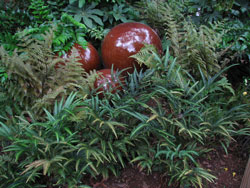Resource Library
Plant of the Week: Holly, East India Fern
The University of Arkansas System Division of Agriculture does not promote, support or recommend plants featured in "Plant of the Week." Please consult your local Extension office for plants suitable for your region.
Plant of the Week
East India Holly Fern
Latin: Arachniodes simplicior

Gardens without ferns, at least to me, are like cake without icing. Ferns can be subtle fill-in plants between big, leafy things or they can be massed in beautiful subtle groundcover beds. The East India holly fern (Arachniodes simplicior) is a beautiful fern that combines the subtle beauty of the traditional fern with colorful foliage of a variegated plant.
Arachniodes are a group of about 150 tropical and temperate species of Asian and Polynesian ferns that were given the Greek name for a spider web, probably because of the appearance of one of the more finely dissected species with delicate fronds. A. simplicior 'Variegata' is the most common of the genus in cultivation, and it has been offered since at least 1990. This fern is classified as belonging to the wood fern family, the Dryopteridaceae, and is native to a wide swath of South Asia, including coastal areas of China and Japan.
The East India holly fern is an evergreen creeper that spreads by means of slowly spreading rhizomes. Clumps of the fern are usually 16 to 24 inches tall with the leaves leathery and three times divided. In this species, the three basal pinnae pairs are significantly larger than those at the tip of the frond. The variegation pattern is a one-quarter inch band of yellow running the central stem (rachis) of the frond and major subdivisions.
Ferns are a joy to grow, but a challenging group of plants to learn. Most are built on a very similar body plan and they look an awful lot alike. Without flowers, botanists have relied primarily on the shape of the spore-bearing bodies (the sori) on the underside of the frond and the sporangia, the balloon-like structures produced in the sorus that actually generate the nearly invisible spores.
Because much of the fern identification work is done under the dissecting scope, a body of technical terminology has emerged that makes it difficult for the casually interested to penetrate the world of fern identification. The website http://hardyfernlibrary.com/ferns/home.cfm, though plenty technical, performs a great service for those interested in hardy ferns. The site pulls together a lot of scattered information about ferns and links to lots of photos, so if you can get close in identifying a species, you can search through it and identify an unknown species without getting bogged down in the technical jargon.
East India holly fern is hardy through zone 7, which means it will survive to zero or slightly below. Most ferns are slow to establish, but once established are long lived in the garden. This fern has some drought tolerance but, like most ferns, performs best in a rich, organic, moist but well-drained site. In my zone 7 garden, the plant in the best site has survived for almost 15 years but is still small, only making a clump about a foot tall and wide. It does better in areas with less harsh winters, where plants will be twice as big.
Hardy ferns are enjoying a renaissance in the garden, and it is likely more will be available in years to come. The texture and beauty of the plants is their main delight, but they also appeal to the intellectually curious gardener who wants to collect, study and observe plant performance over a long period.
By: Gerald Klingaman, retired
Extension Horticulturist - Ornamentals
Extension News - August 13, 2010
The University of Arkansas System Division of Agriculture does not maintain lists of retail outlets where these plants can be purchased. Please check your local nursery or other retail outlets to ask about the availability of these plants for your growing area.